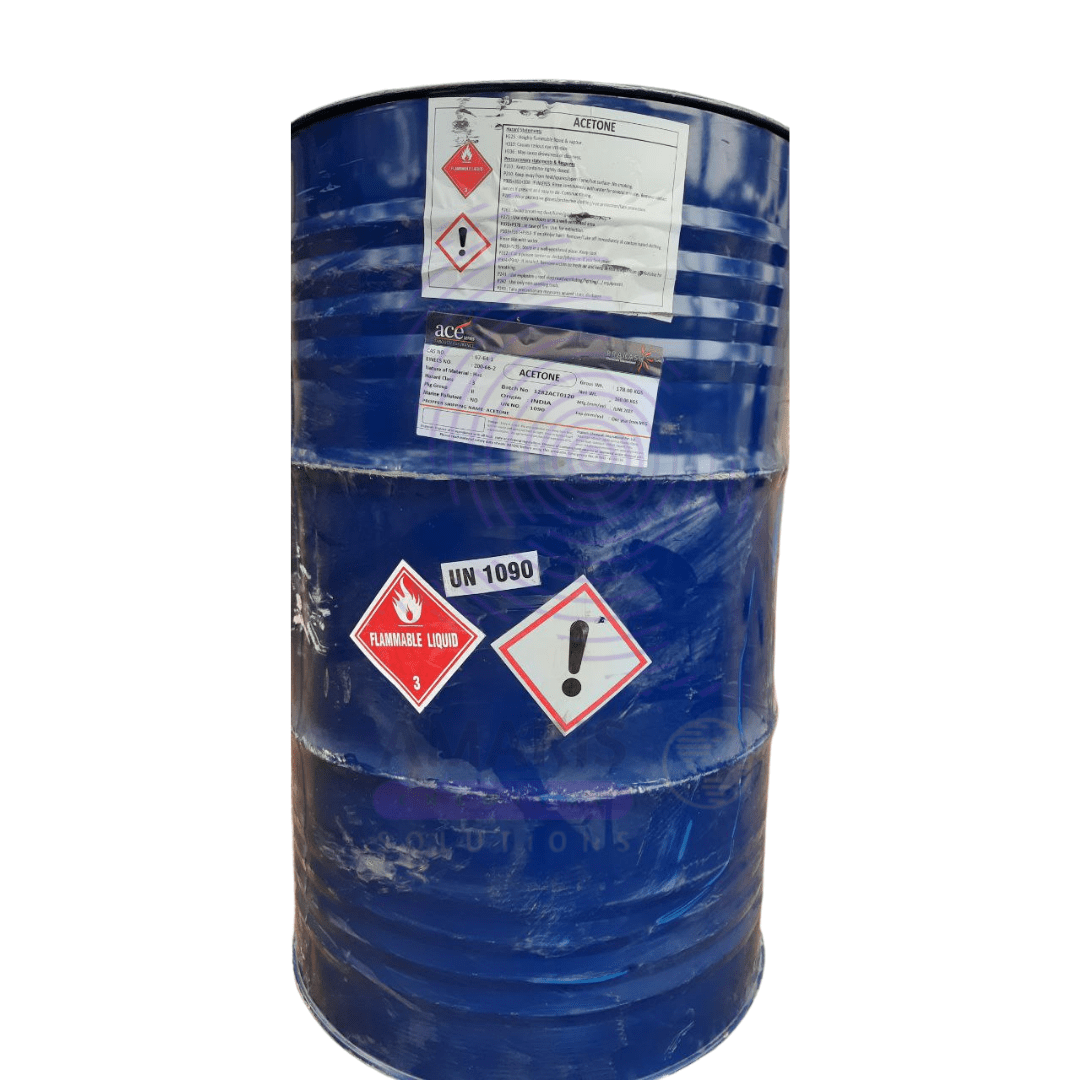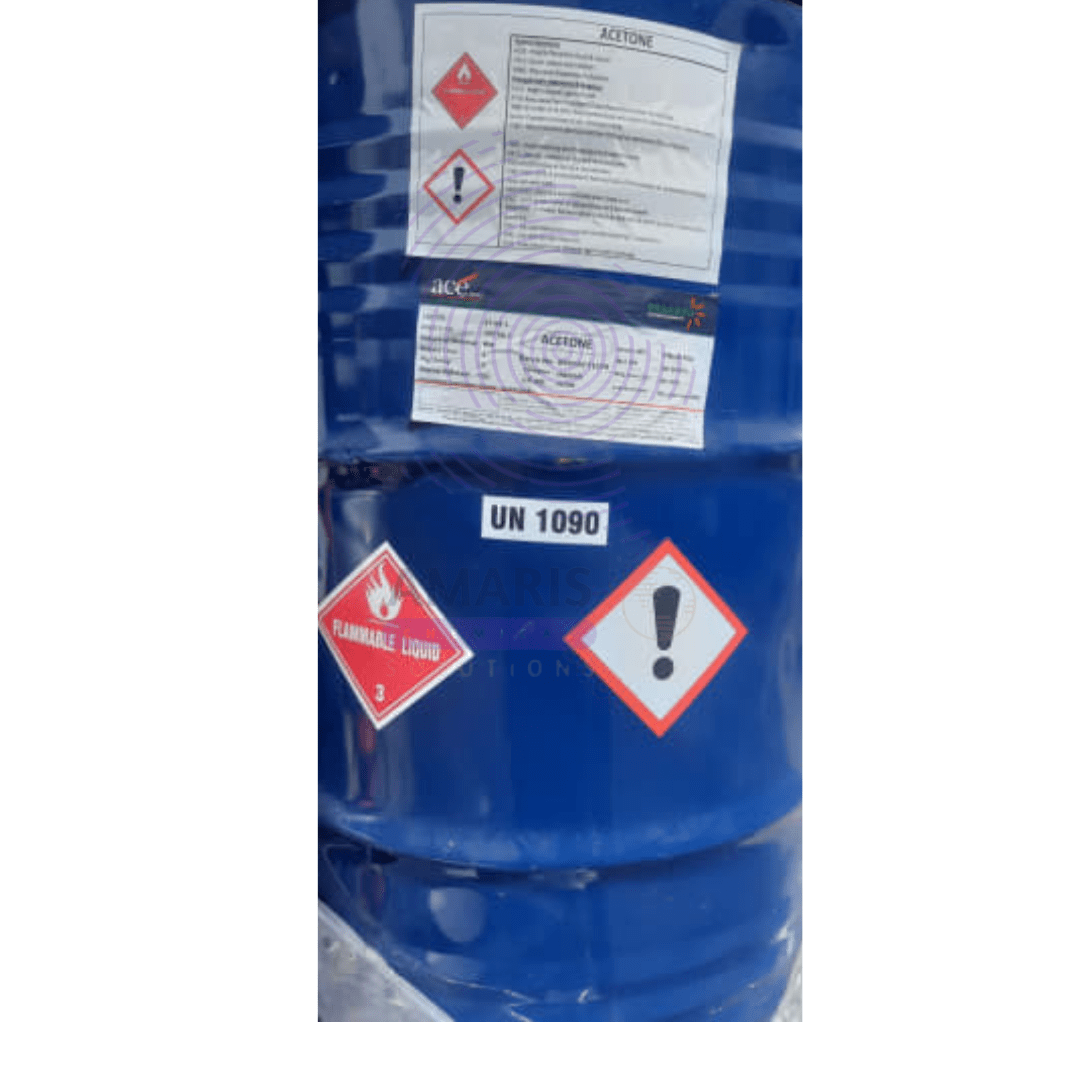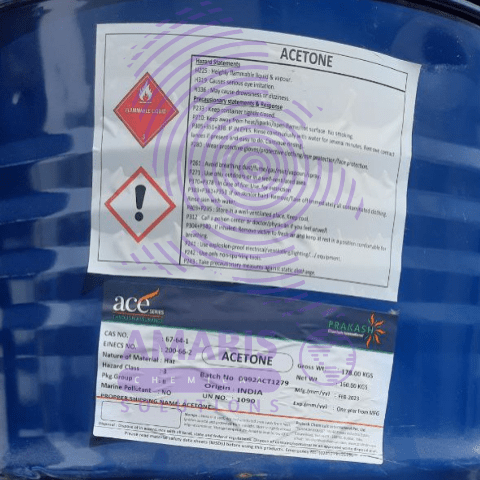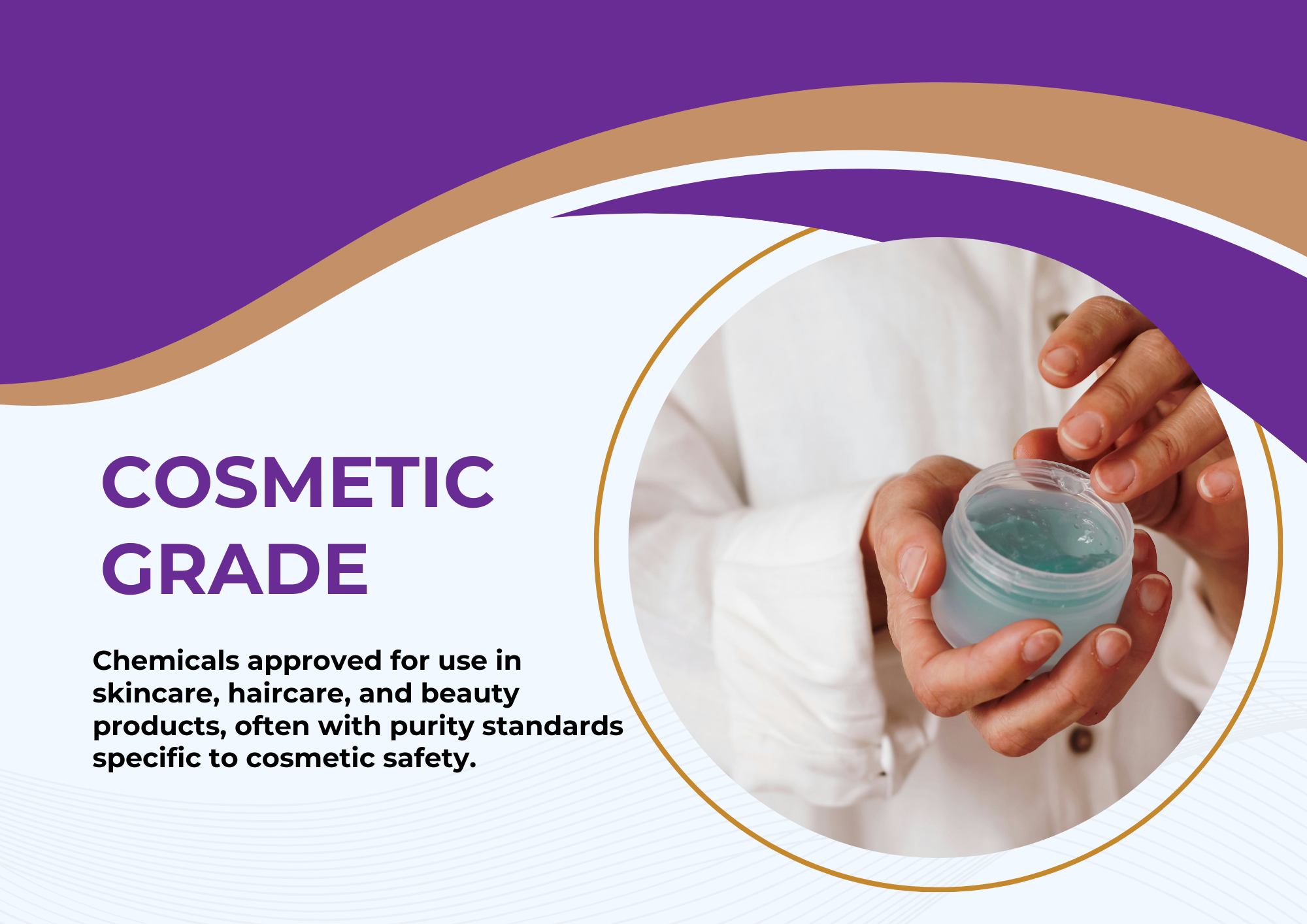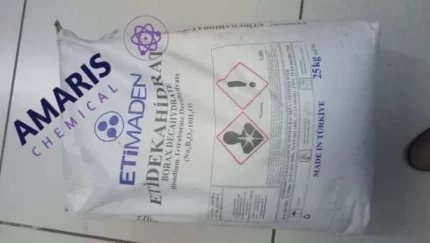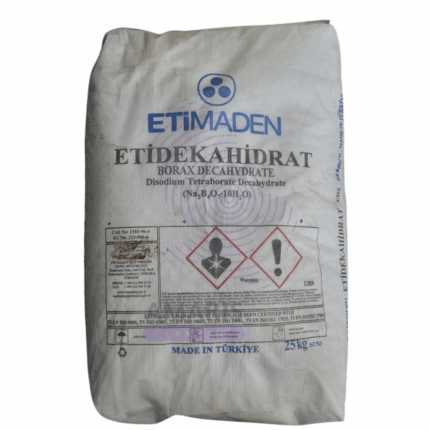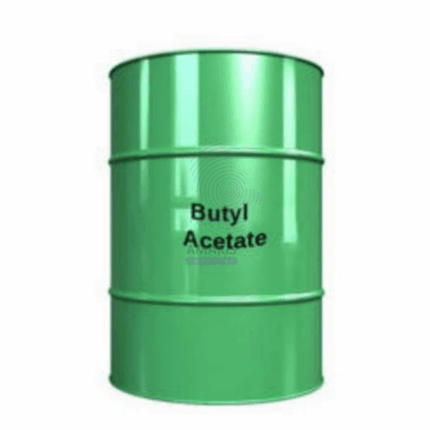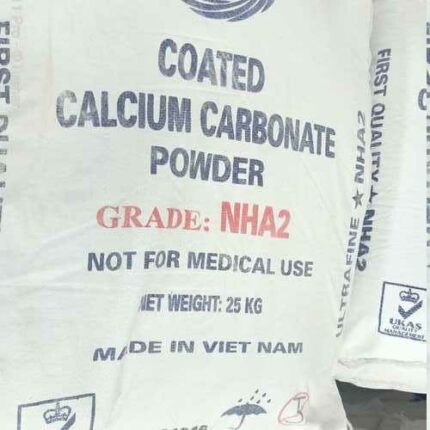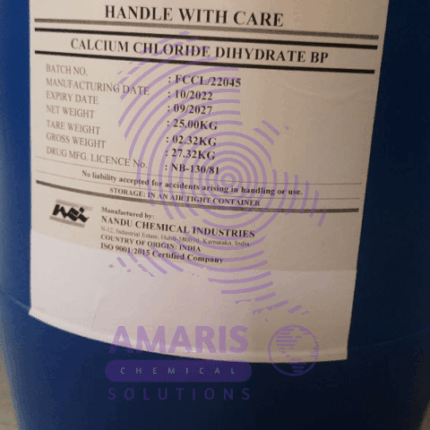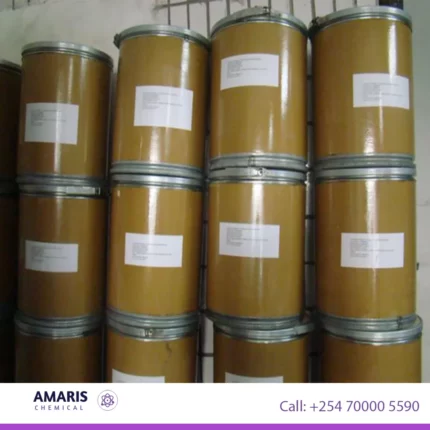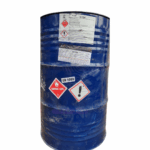


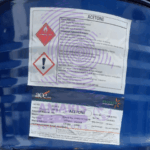
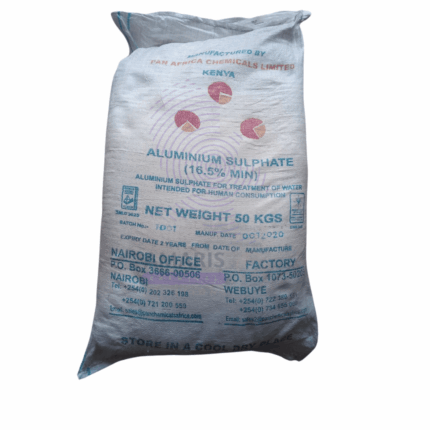
Aluminium Sulphate powder (Alum)
$6,000.00 Original price was: $6,000.00.$5,000.00Current price is: $5,000.00.
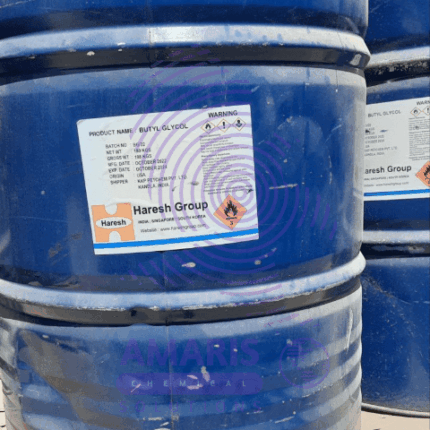
Butyl Glycol
$87,000.00 Original price was: $87,000.00.$86,000.00Current price is: $86,000.00.
Acetone
$56,000.00 Original price was: $56,000.00.$52,668.00Current price is: $52,668.00.
Whatsapp Order
Acetone
Acetone is a colorless, flammable liquid with a sweet, fruity odor. It is a common organic solvent that is widely used in the production of plastics, fibers, drugs, and other chemical compounds. Acetone is also commonly used as a cleaning agent and a nail polish remover. Chemically, it is the simplest ketone and is represented by the formula CH3COCH3.
SKU:
ACS11193CHEM0
Categories: Excipients, Analytical Reagents, Electronic Chemicals, Solvents (paint), Solvents (pharmaceutical)
Tags: acetone, nail polish remover, solvent
Description
Acetone Uses
It is a colourless, volatile, flammable organic solvent which occurs naturally in trees, vehicle exhaust, plants and as a breakdown product of animal fat for metabolism. It has a sweetish (fruity) odour. The molecular formula for the compound is CH3-CO-CH3 or CH3COCH3 or C3H6O. Other names that identify the chemical are 2-propanone, dimethyl ketone, and beta ketopropane. It dissolves in water, is toxic in high doses, is the simplest ketone. Its vapours are denser than air and it has a flash point of 0 degrees Fahrenheit. It has a boiling point of 133 degrees Fahrenheit at 760mm Hg (NTP, 1992) and a melting point of 137 degrees Fahrenheit (NTP, 1992). Its solubility is greater than or equal to 100mg/ml at 72 degrees Fahrenheit (NTP, 1992).
Some of the areas of application of Acetone include:
1. It is applied in indirect refrigeration as a brine for low-temperature heat transfer.
2. It is used in cleaning and drying precision parts.
3. It is applied as a corrosion inhibitor in hydraulic fracturing.
4. It is applied as a solvent and as a reaction intermediate for the production of other compounds that are mainly used as solvents.
5. It is applied in the manufacture of pharmaceuticals and cosmetics as a solvent.
6. It is used to store acetylene safely in gas cylinders.
7. It is used in spinning cellulose acetate fibres.
8. It is used in the manufacture of smokeless powder.
9. It is applied in boat manufacturing as a washing solvent in fibreglass.
10. It is applied in the electronic industry as a cleaning solvent.
11. It is applied as a solvent in the degumming of silk and the degreasing of wool.
12. It is applied in the formulations of surface coatings and related thinners and washes.
13. It is applied as a solvent for printing inks.
14. It is used as a varnish (nail polish) remover.
15. It is applied in the purification of paraffin.
16. It is used to harden and dehydrate tissues for extraction of various principles from plant and animal substances.
17. In cleaning, it is used to dissolve hazardous chemical spills.
18. It is used in rubber cement.
19. It is applied as a solvent in plastics and other synthetic fibres.
Additional information
| APPEARANCE |
Watery/Thin – Low viscosity e.g., ethanol |
|---|---|
| COUNTRIES OF ORIGIN |
CHINA ,TAWAIN |
| CONCENTRATION |
99.9% |
| AVAILABLE PACK SIZE |
160kg ( Metal or Plastic drum) |
KEY ATTRIBUTES
1. Basic Identification Attributes
- Chemical Name: Propan-2-one (IUPAC), Acetone (common)
- CAS Number: 67-64-1
- HS Code: 2914.11.00
- Molecular Formula: C₃H₆O
- Synonyms: Dimethyl ketone, 2-propanone, β-ketopropane, propanone
2. Physical & Chemical Properties
- Physical State: Colorless, volatile liquid
- Color & Odor: Colorless; sweet, pungent odor
- Boiling Point: 56.05°C
- Melting Point: -94.7°C
- Density: 0.791 g/cm³ at 20°C
- Solubility:
- Miscible with water, ethanol, ether, chloroform
- Soluble in most organic solvents
- pH Level: ~7 (neutral)
- Vapor Pressure: 233 mmHg at 25°C
- Flash Point: -20°C (closed cup)
- Autoignition Temperature: 465°C
- Viscosity: 0.32 cP at 25°C
- Refractive Index: 1.3588 at 20°C
3. Safety & Hazard Attributes
- Hazard Class:
- Flammable Liquid Category 2
- Eye Irritant Category 2B
- STOT Single Exposure Category 3
- NFPA Ratings: Health-1, Flammability-3, Reactivity-0
- Exposure Limits:
- OSHA PEL: 1000 ppm (2400 mg/m³) TWA
- ACGIH TLV: 500 ppm (1180 mg/m³) TWA
- NIOSH REL: 250 ppm (590 mg/m³) TWA
- Reactivity:
- Forms explosive peroxides with strong oxidizers
- Reacts violently with chlorosulfonic acid, nitric acid
- Incompatible with strong acids, bases, oxidizing agents
4. Storage & Handling Attributes
- Storage Conditions:
- Store in cool, well-ventilated area away from heat/sparks
- Keep containers tightly closed
- Temperature: <30°C recommended
- Incompatible Materials:
- Strong oxidizers, acids, bases, reducing agents
- Chloroform, bromine, amines
- Container Type:
- Steel, aluminum, or HDPE containers
- Glass for laboratory quantities
- Shelf Life: Indefinite if properly stored
- Special Handling:
- Ground all equipment to prevent static sparks
- Use explosion-proof electrical equipment
- PPE: Chemical goggles, gloves (nitrile), vapor respirator if needed
5. Regulatory & Compliance Attributes
- Regulatory Status:
- EPA: Listed under TSCA
- REACH: Registered
- OSHA: Regulated under 29 CFR 1910.1000
- DOT: UN 1090, Class 3, PG II
- Hazard Symbols:
- GHS Pictograms: Flame, Exclamation Mark
- Transportation Restrictions:
- Proper shipping name: Acetone
- Hazard class: 3 (Flammable liquid)
- Packing group: II
- Waste Disposal:
- RCRA hazardous waste (D001 for ignitability)
- Incineration is preferred method
6. Environmental & Health Impact
- Ecotoxicity:
- LC50 (fish): 4,400-13,100 mg/L (96h)
- EC50 (daphnia): 6,800 mg/L (48h)
- Persistence:
- Readily biodegradable (BOD5: 60-70% of ThOD)
- Atmospheric half-life: ~22 days
- Carcinogenicity:
- IARC: Not classified
- NTP: Not listed
- ACGIH: A4 (not classifiable as human carcinogen)
- Biodegradability:
- BOD5/COD ratio: 0.5-0.7 (readily biodegradable)
- Complete degradation in 5-30 days
SAFETY PRECAUTIONS
General Handling:
- Use in well-ventilated areas(flammable vapors can accumulate)
- Avoid open flames, sparks, and heat sources(extremely flammable liquid)
- Ground containers during transfer to prevent static electricity sparks
- Use non-sparking tools in acetone environments
Personal Protective Equipment (PPE):
- Gloves:Nitrile or neoprene (latex offers poor protection)
- Eye Protection:Chemical splash goggles
- Respiratory Protection:Organic vapor respirator if ventilation is inadequate
- Clothing:Flame-resistant lab coat/apron
Storage:
- Store in approved flammable liquid cabinets
- Keep containers tightly closed when not in use
- Store away from oxidizers, acids, and bases
- Maximum storage temperature: 25°C (77°F)
Spill Management:
- Small spills: Absorb with inert absorbents(vermiculite, sand)
- Large spills: Contain with spill berms, prevent entry into drains
- Evacuate area if vapors exceed exposure limits
Skin Contact:
- Symptoms:Dryness, irritation, possible dermatitis
- Action:
- Remove contaminated clothing
- Wash with soap and waterfor 15 minutes
- Apply moisturizer if irritation persists
Eye Contact:
- Symptoms:Redness, pain, temporary corneal damage
- Action:
- Immediately flush with lukewarm water for 20 minutes
- Hold eyelids open during flushing
- Seek medical attention if irritation continues
Inhalation:
- Symptoms:Dizziness, headache, nausea, CNS depression
- Action:
- Move to fresh air immediately
- Administer oxygen if breathing is difficult
- Seek medical help for prolonged exposure
Ingestion:
- Symptoms:Nausea, vomiting, drowsiness
- Action:
- Do NOT induce vomiting
- Rinse mouth with water
- Give 1-2 glasses of water to drink
- Seek immediate medical attention
Fire Hazards:
- Extremely flammable liquid and vapor
- Flash point: -20°C (-4°F)
- Vapor/air mixtures are explosive (2.5-12.8% by volume)
- Vapors are heavier than air - may travel to ignition sources
Extinguishing Methods:
- Recommended:
- Alcohol-resistant foam
- CO₂ extinguishers
- Dry chemical powder (Class B)
- Not Recommended:
- Water jets (ineffective, may spread fire)
- Water spray (only for cooling exposed containers)
Firefighting Procedures:
- Wear self-contained breathing apparatus (SCBA)and full protective gear
- Stop leak if safe to do so
- Cool nearby containers with water sprayto prevent explosion
- Allow controlled burning if leak cannot be stopped
- Evacuate area if fire becomes uncontrollable
Emergency & Regulatory Information
- NFPA Rating:Health 1, Flammability 3, Instability 0
- GHS Hazard Statements:
- H225: Highly flammable liquid and vapor
- H319: Causes serious eye irritation
- H336: May cause drowsiness or dizziness
- OSHA PEL:1000 ppm (TWA)
- Emergency Contacts:Poison Control, local fire department
You may also like…
Acetone Extra Pure
Acetone Extra Pure
Acetone is a colorless, flammable liquid with a sweet, fruity odor. It is a common organic solvent that is widely used in the production of plastics, fibers, drugs, and other chemical compounds. Acetone is also commonly used as a cleaning agent and a nail polish remover. Chemically, it is the simplest ketone and is represented by the formula CH3COCH3.
Related products
Acesulfame K
$0.00
Acesulfame K
Acesulfame K, also known as Acesulfame Potassium or Ace-K, is a high-intensity artificial sweetener that is commonly used as a sugar substitute in various food and beverage products. It is a white, odorless powder that is about 200 times sweeter than sucrose (table sugar), but it has no caloric value and does not affect blood sugar levels. Acesulfame K is chemically stable and can withstand high temperatures, making it suitable for use in baked goods and other heat-processed products. It is often found in sugar-free or low-calorie products, such as diet sodas, sugar-free chewing gums, desserts, and tabletop sweeteners.
Aluminum Fine Powder
Aluminum fine powder is a lightweight, highly reactive silvery-white powder valued for its excellent thermal and electrical conductivity, as well as its reflective properties. Primarily used in pyrotechnics to create bright flashes and sparks in fireworks and explosives, it also plays a crucial role in metallurgy for producing alloys and additive manufacturing (3D printing). In industrial applications, it serves as a reducing agent in chemical processes and generates hydrogen for fuel research. The powder is widely incorporated into metallic paints and coatings for reflective finishes, conductive pastes for electronics, and specialty construction materials like aerated concrete. Available in micron to nano-sized particles, aluminum fine powder requires careful handling due to its flammability and reactive nature with water or acids. Its versatility extends to cosmetics, where ultra-fine grades provide shimmer in nail polishes and eye shadows, demonstrating its broad utility across multiple high-tech and traditional industries.
Borax Decahydrate
Borax decahydrate, also known as sodium borate, is a naturally occurring mineral composed of sodium, boron, oxygen, and water. It is a white, odorless powder that dissolves easily in water, and has a wide range of uses, including as a laundry detergent booster, a multipurpose cleaner, and as a component in the production of glass, ceramics, and enamel. Borax has antifungal and insecticidal properties and is also used in certain industrial applications such as in the production of fiberglass, as a flux in metallurgy, and as a fire retardant. It is considered safe when used as directed, but can be toxic if ingested in large quantities.
Butyl Acetate
Butyl Acetate (n-Butyl Acetate, C₆H₁₂O₂) is a high-performance industrial solvent widely recognized for its excellent solvency, moderate evaporation rate, and pleasant fruity aroma. This clear, flammable liquid is a preferred choice in paints, coatings, and printing inks due to its ability to dissolve resins and polymers effectively while ensuring smooth application and quick drying. Its versatility extends to adhesives, where it enhances bonding strength and drying speed, as well as to the electronics industry, where it serves as a reliable cleaning agent for circuit boards and precision components. Butyl acetate is also valued in pharmaceutical and cosmetic formulations as a flavoring agent and extraction solvent. With its low toxicity and balanced properties, it offers a safer alternative to more aggressive solvents, making it ideal for industrial and commercial applications where both performance and safety are paramount. Proper handling and ventilation are recommended to ensure safe usage.
Calcium carbonate (Coated)
Calcium Carbonate (coated) refers to a form of calcium carbonate in which the individual particles of the mineral are coated or encapsulated with a layer of a different material. This layer can be composed of various substances, such as stearic acid, fatty acids, or other polymers. The purpose of the coating is to modify the surface properties of the calcium carbonate particles, such as their hydrophobicity or compatibility with other materials, making them more suitable for specific applications. Coated calcium carbonate is widely used in industries such as plastics, paper, paints, and coatings, where it can improve the properties of the final product, such as brightness, whiteness, and durability.
Calcium chloride Dihydrate
Calcium chloride dihydrate is a chemical compound with the molecular formula CaCl2·2H2O. It is a crystalline salt that is highly soluble in water and has a variety of industrial and medical applications. It is commonly used as a desiccant to absorb moisture, as a de-icing agent for roads and sidewalks, and as a food preservative. It is also used in the production of cement, as a laboratory reagent, and in medicine as a source of calcium for intravenous therapy.
Calcium Saccharin
$0.01
Calcium saccharin, also known as calcium cyclamate, is a synthetic sweetener derived from saccharin. It is a calcium salt of saccharin, and it is often used as a sugar substitute in various food and beverage products. Calcium saccharin is several hundred times sweeter than sugar, yet it contains no calories and does not affect blood sugar levels, making it suitable for individuals with diabetes or those looking to reduce their sugar intake. It is commonly used in tabletop sweeteners, diet sodas, baked goods, and other low-calorie or sugar-free products
Cellulose Ether
Rated 5.00 out of 5
Cellulose ether are a group of water-soluble polymers that are derived from cellulose, which is the most abundant natural polymer on earth. Cellulose ethers are produced by chemically modifying the cellulose molecule through a variety of reactions, such as etherification or esterification, resulting in different functional groups attached to the cellulose backbone. These modifications can alter the physical and chemical properties of cellulose, making it more soluble in water and providing a range of functional properties, such as thickening, binding, stabilizing, and emulsifying, that make cellulose ethers useful in a wide range of industries, including food, pharmaceuticals, cosmetics, and construction.



 LABORATORY EQUIPMENT & APPARATUS
LABORATORY EQUIPMENT & APPARATUS
 Fertilizers
Fertilizers Plant Growth Regulators
Plant Growth Regulators Soil Conditioners
Soil Conditioners Animal Feed Additives
Animal Feed Additives Biostimulants
Biostimulants Dough Conditioners
Dough Conditioners Flour Treatments
Flour Treatments Fat Replacers
Fat Replacers Preservatives (baking)
Preservatives (baking)
 Surfactants (cleaning)
Surfactants (cleaning) Builders
Builders Bleaching Agents
Bleaching Agents Enzymes
Enzymes Solvents (cleaning)
Solvents (cleaning) Fragrances
Fragrances

